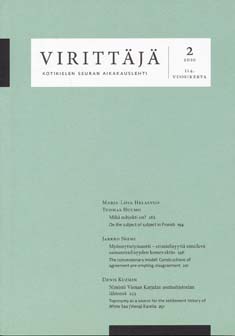Myönnyttelymuotti – erimielisyyttä enteilevä samanmielisyyden konstruktio [The concessionary model: Constructions of agreement pre-empting disagreement]
Abstrakti
Kirjoittaja käsittelee myönnyttelymuotiksi kutsumansa konstruktion käyttöä. Myönnyttelymuotti on nollasubjektikonstruktio, joka rakentuu mahdollisuutta ilmaisevasta modaaliverbistä (voida, saada, sopia tai passata), liitepartikkelista -hAn, sävypartikkelista sitä sekä A-infinitiivin perusmuodosta. Muotin mukaisia lauseita ovat esimerkiksi Voihan sitä sanoa ja Saahan sitä toivoa. Kirjoittaja tarkastelee muotin käyttöä Couper-Kuhlenin ja Thompsonin (2000) esittämässä peruskonsessiivin (cardinal concessive) skeemassa. Sen mukaisessa toimintajaksossa myönnyttelymuotti osoittaa samanmielisyyttä tai hyväksyntää toisen puhujan esittämälle mielipiteelle tai toimintatavalle siten, että samanmielisyyden tai hyväksynnän esitystä seuraa ainakin osin erimielinen eli kontrastiivinen mielipide.
Artikkeli perustuu 328 esimerkin aineistoon, josta suurin osa on poimittu internetissä. Internetin lisäksi kirjoittaja hyödyntää Kielipankin sanomalehtikorpuksia sekä kaunokirjallisuudesta löytyneitä esimerkkejä. Tutkimuksessa limittyy kaksi funktionaalista kielentutkimuksen suuntausta: Se tarkastelee myönnyttelymuottia vakiintuneena muodon ja merkityksen yhteenliittymänä eli konstruktiona kognitiivisen kieliopin ja konstruktiokieliopin kehyksessä. Toisaalta se tarkastelee vuorovaikutuksen vakiintunutta toimintojaksoa keskustelunanalyysin ja vuorovaikutuslingvistiikan näkökulmasta.
Artikkeli käsittelee kahta myönnyttelymuotin käyttöä. Näistä ensimmäisessä myönnyttelymuotti rakentaa puhekumppaneiden eli myönnytellyn mielipiteen esittäjän ja myönnyttelijän välistä yhteisymmärrystä. Tässä kirjoittajan neuvottelevaksi kutsumassa käytössä myönnyttelymuottia hallitsee yleensä verbimuoto voihan. Neuvottelevassa käytössä muotin esiintymää seuraa eksplisiittinen kontrasti, joka ei kiistä puhekumppanin näkemystä, mutta lisää siihen jonkin näkökulman tai pyrkii osoittamaan vaihtoehtoisen tavan tarkastella puheenalaista asiaintilaa. Toisessa käytössä myönnyttelymuotti implikoi jo itsessään kontrastin eikä sitä välttämättä seuraa ilmipantu kontrasti kuten neuvottelevassa käytössä. Myönnyttelymuotti on tällöin affektinen ja merkitykseltään pikemminkin puheenalaisen mielipiteen kieltävä kuin sen tunnustava. Affektisessa käytössä muottia hallitsee yleensä verbimuoto saahan, sopiihan tai passaahan. Myönnyttelymuottia käytetään affektisesti silloin, kun pyritään vaikuttamaan puhekumppanin ja usein myös viestintätilanteen muiden osallisten mielipiteisiin siten, että näennäisesti myönnytelty mielipide tai toimintatapa hylätään.
---
The concessionary model: Constructions of agreement pre-empting disagreement
In this paper, the author examines the use of a construction he calls the ‘concessionary model’. The concessionary model is a zero-subject construction, which uses a modal verb expressing possibility (voida ‘to be able’, saada ‘to be allowed’, sopia ‘to be acceptable’ or passata ‘to be agreeable’), the enclitic particle -hAn, the tone particle sitä, and the basic, first infinitive form of the verb ending in A. Examples of clauses using this construction are, Voihan sitä sanoa ‘one could say’ and Saahan sitä toivoa ‘one may hope’. The author examines the use of this construction from the perspective of the cardinal concessive schema presented by Couper-Kuhlen and Thompson (2000). Seen in this light, the concessionary model offers agreement with or acceptance of the opinions or actions of another speaker in such a way that the expression of acceptance is followed, at least in part, by a disagreeing or contrasting opinion.
The article is based on a corpus of 328 examples, the majority of which have been taken from the Internet. As well as examples from the Internet, the author makes extensive use of the newspaper corpus held at the Language Bank of Finland and examples from literary texts. This article employs two functional strands of linguistic research: it examines the concessionary model as an established coalescence of form and meaning (i.e. as a construction) within the framework of cognitive grammar and construction grammar. On the other hand, it assesses the established functions of interaction from the perspective of conversation analysis and interactional linguistics.
The article examines two uses of the concessionary model. In the first of these uses, the concessionary model establishes a shared understanding between the two speakers, i. e. between the person presenting a concessionary opinion and the person conceding the point. In this construction, which the author calls the ‘negotiation mode’, the concessionary model is normally governed by the verb form voihan ‘indeed it may’. In its negotiation mode, the concessionary model is normally followed by an explicit contrast, which does not refute the view of the opposing speaker but which adds another perspective or attempts to present an alternative way of viewing events. In its other use, the concessionary model already implies this contrast and is therefore not necessarily followed by another contrast, as in the negotiation mode. In these instances the concessionary model is affective and serves more to refute the view presented rather than to affirm it. In its affective use the model is governed by the verb forms saahan ‘one may well’, sopiihan ‘it may be appropriate’ or passaahan ‘indeed it is agreeable’. The concessionary model is used in an affective manner in an attempt to affect the views of the other speaker(s) in the situation, so that a position, which has seemingly been conceded, is in fact rejected.






